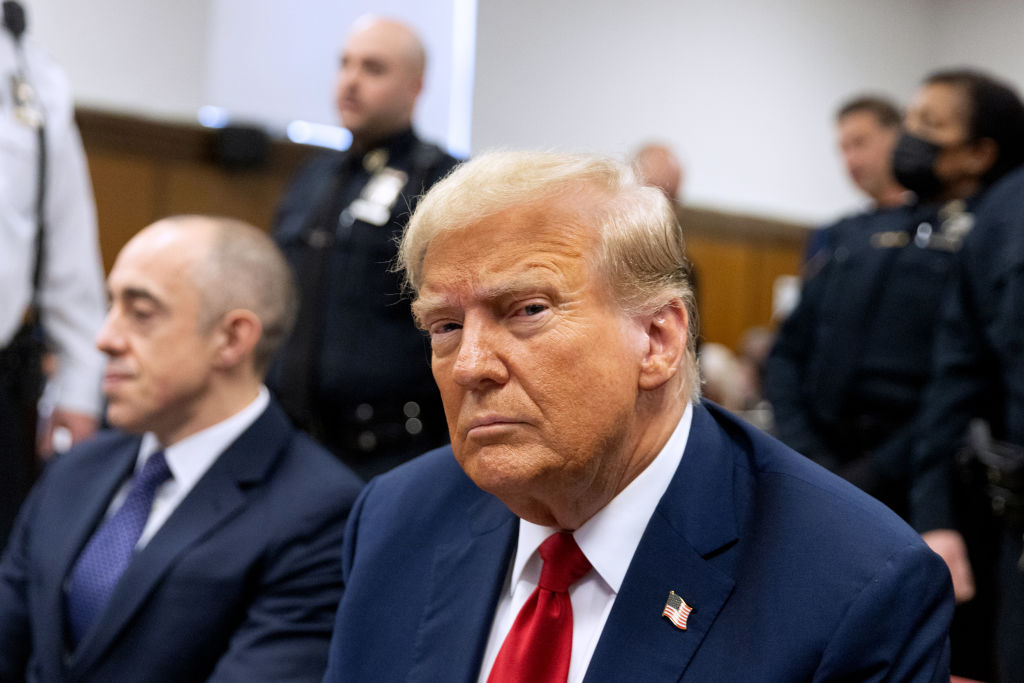Welcome back to The Collision as we settle into the substance of Donald Trump’s hush-money trial in Manhattan, which began in earnest on Monday with opening statements and the prosecution calling its first witness. We’ll also examine some developments this week in the classified documents case in Florida. We’ll even get into a new indictment related to the 2020 election that dropped Wednesday. Strap in!
The Docket
- Tuesday’s resumption of the prosecution’s case was paused so that Judge Juan Merchan could hear arguments about whether Donald Trump violated the gag order not to disparage witnesses, court staff, or opposing counsel. Merchan did not make a ruling on Tuesday, but it was apparent defense counsel did not leave a great impression with the judge. “You’re losing all credibility, I have to tell you right now,” Merchan reportedly told Trump attorney Todd Blanche. “You’re losing all credibility with the court.” It’s unclear when Merchan will issue a ruling.
- The main argument at the center of the gag order hearing was whether Trump’s social media posts sharing the views of others constituted a violation of the order that Trump himself not make disparaging remarks. Blanche argued that when Trump shared the commentary of others (such as his Truth Social post last week paraphrasing Fox News host Jesse Watters) that “common sense” should dictate that Trump was not expressing those views himself. Merchan seemed highly skeptical of this, noting that posting something on one’s own account requires an “action” by the user.
- Just to add to his attorneys’ headaches, here’s what Trump posted on Truth Social just after Tuesday’s hearing: “HIGHLY CONFLICTED, TO PUT IT MILDLY, JUDGE JUAN MERCHAN, HAS TAKEN AWAY MY CONSTITUTIONAL RIGHT TO FREE SPEECH. EVERYBODY IS ALLOWED TO TALK AND LIE ABOUT ME, BUT I AM NOT ALLOWED TO DEFEND MYSELF. THIS IS A KANGAROO COURT, AND THE JUDGE SHOULD RECUSE HIMSELF!” And on Thursday morning, prosecutors raised four additional potential violations with Merchan.
- Speaking of Truth Social, it’s worth perusing Trump’s account on his proprietary social media platform to see just how frequently he comments about his own legal issues. Last Friday, for instance, Trump posted five times in a row to argue that he is immune from prosecution for actions he took as president.
- About that argument: Trump’s attorneys are appearing before the Supreme Court today to argue his immunity. We’ll have a bonus edition of The Collision tomorrow to evaluate that case, so stay tuned. Meanwhile, give a read to this op-ed in the New York Times from former Rep. Liz Cheney arguing why the court should reject Trump’s immunity claim.
- A grand jury in Arizona has indicted the former chair of the Arizona GOP, Kelli Ward, and 10 others who put themselves forward as presidential electors for Trump in 2020, despite Joe Biden winning the state by more than 10,000 votes. According to the indictment, which was unsealed Wednesday, the 11 so-called fake electors are being charged on multiple felony counts, including conspiracy, fraud, and forgery.
- Attorney General Kris Mayes, a Democrat, issued a video statement Wednesday explaining the indictment. “We’re here because justice demands an answer to the efforts that the defendants and other unindicted co-conspirators allegedly took to undermine the will of Arizona’s voters during the 2020 presidential election,” Mayes said.
- There are also several additional co-defendants whose names were redacted—presumably because they have not yet been served with indictments. The Washington Post has identified these co-defendants as former Trump White House chief of staff Mark Meadows; attorneys Rudy Giuliani, Jenna Ellis, John Eastman, and Christina Bobb; top campaign adviser Boris Epshteyn; and former campaign aide Mike Roman. Several of these were also indicted in the Georgia election-interference case alongside Trump, who is identified in the Arizona indictment as an unindicted co-conspirator.
- Here’s a good nugget from a CNN story about how the House Republicans’ impeachment inquiry into President Joe Biden has collapsed, from an anonymous Republican lawmaker about House Oversight Committee Chairman James Comer: “Comer is hoping Jesus comes so he can get out. … He is fed up.”
- Finally, does it feel like a lot of mainstream cable news commentary on Trump’s legal issues sounds remarkably the same? Politico has a juicy report on the regular off-record calls involving many of the talking heads you see pop up on CNN and MSNBC.
Bragg’s Evidence Reveals Seamy Schemes

How much do we really understand about how Donald Trump operates behind the scenes? The former president’s ongoing criminal trial may give us new insight into how he and the people around him deal with political crises in the moment—in this case, during the final months of the 2016 election.
Even before Trump’s descent down the Trump Tower escalator in 2015, he had for decades been a tabloid mainstay who became a household name as much for his business and personal dramas as his successes. So much of Trump’s activity is public, narrated in real time by Trump himself to give us a warped account of what is going on as we’re learning about it. And his political career has created an oversaturated market of Trump coverage, with countless tell-all books and reported insider accounts of how Trump’s campaign, his White House, and his post-presidency political apparatus really work. The veracity and utility of these accounts vary, and many are plainly colored by the biases of the sources or narrators.
Manhattan District Attorney Alvin Bragg’s evidence may be defensible as far as a jury is concerned. But that evidence likely will go a long way to telling in detail—with real-time text messages and even a voice recording of Trump—a seamy story of payoffs to mistresses in an agreement with a tabloid publisher. And all of it will be told in the context of a criminal trial, with witnesses testifying under oath.
Prosecutor Matthew Colangelo, in his opening statement Monday, discussed the arrangement between Trump, his then-lawyer Michael Cohen, and the publisher of the National Enquirer, David Pecker, as a “conspiracy” designed to help Trump avoid embarrassing stories coming out about him before the 2016 election.
Pecker has already testified that the “catch and kill” agreement with Cohen, in which the Enquirer would buy the rights to a damaging story related to Trump and not publish it, was forged in a 2015 meeting at Trump Tower just before Trump launched his presidential campaign. In exchange, Cohen would feed the Enquirer negative, salacious stories about Trump’s Republican rivals, according to Pecker. On the stand Tuesday, Pecker said he told Trump at this meeting that he would be his “eyes and ears.”
“If I hear anything negative about yourself, or if I hear anything about women selling stories, I would notify Michael Cohen, as I did over the last several years,” Pecker recalled telling Trump.
Colangelo said to expect to hear about the negotiations by the Enquirer to buy the rights for the story of an alleged affair with Trump from the woman herself, former Playboy model Karen McDougal, in the summer of 2016. Cohen’s frequent communication with Pecker about the state of those negotiations will make it into evidence.
“You are going to see the flurry of text messages, the barrage of phone calls around those conversations and around that meeting,” the prosecutor said Monday.
Colangelo said prosecutors will share in court an audio recording made by Cohen of his September 2016 conversation with Trump planning the creation of a shell company to pay American Media Incorporated, the parent of the Enquirer, to catch and kill McDougal’s story. The arrangement never came to fruition after Pecker got “cold feet” but matches Trump’s approach when it came to the payoff at the center of this trial, the one to Stormy Daniels, Colangelo said.
One of the more intriguing pieces of evidence Colangelo previewed in his opening statement is a text message the prosecution will use to argue that all involved in the scheme knew it was giving an assist to Trump’s electoral chances. The text, from the lawyer for Daniels (who also represented McDougal) to Enquirer Editor-in-Chief Dylan Howard, was sent on the night of the 2016 election once it became clear Trump might actually win.
“What have we done?” reads the message—a visceral reaction from players of a noisome game who are seeing the consequences of their actions.
Again, the legal consequences for this sort of real-time insight into Trump’s operation may not matter when it comes to convincing a jury the former president is guilty beyond a reasonable doubt of falsifying business records. And it remains untested whether voters in a general election can and will be moved by learning more unsavory aspects of a man whose unsavory character is well-known and baked into their perception of him.
But what this week of Trump’s trial has demonstrated so far is that there is still a lot the public can learn as the evidence reveals the machinations of the man who was and may again be president.
Slow-Walking at Mar-a-Lago
Speaking of lifting the curtain, a cache of exhibits from federal prosecutors in the classified documents case was unsealed this week, offering a glimpse into how special counsel Jack Smith’s team will be pursuing its case against Trump and his co-defendants—and how Trump’s team appeared to casually dismiss or ignore any overtures to comply with the Presidential Records Act.
The exhibits consist of partially redacted FBI interviews with certain individuals and email correspondence during 2021 between members of Trump’s team and government officials, chiefly those from the National Archives team attempting to retrieve presidential records from Trump. One exhibit in particular provides a wealth of insight into the central questions of the case: A 2022 FBI interview with a prominent Trump White House official, identified only as Person 16, told investigators “there was no standing declassification order” from Trump on records he wanted to retain for himself, despite Trump’s defense resting partially on the idea that he had declassified the material before he left the White House.
The exhibits have been unsealed as part of a response from Smith’s team to a motion from the former president’s attorneys to compel the government to provide evidence from a lengthy list in pre-trial discovery. This evidence, Trump’s legal team has argued, would demonstrate that the classified documents investigation leading to the indictment was prompted by “politically motivated” operatives at the National Archives and Records Administration (known as NARA) and elsewhere in the Biden administration.
In his response, Smith argues that beyond there being no legal reason to compel this discovery, the defense “paints an inaccurate and distorted picture of events.” As he attempts to show with his seven exhibits, the record demonstrates not a coordinated effort by a politicized administration trying to sink Trump but instead “only different government agencies, with specific portfolios and responsibilities, at work to solve an increasingly vexing and concerning problem.”
That problem, as Smith’s exhibits show, was getting Trump and his aides to comply with requests from NARA to provide an accounting and delivery of documents they were legally required to turn over. What follows from the evidence Smith provides is a remarkable display of sluggishness on the part of Trump’s team in cooperating, which the prosecution will urge a jury to interpret as intentional.
Take a 2021 email exchange between Trump aides and the general counsel for NARA, Gary Stern, that is Smith’s Exhibit B in his response.
The background has been established in previous news reports, but in brief: Starting on May 6 of that year, Stern reached out directly to Trump aides over email to request the transfer of several different categories of paper presidential records that were missing, including correspondence between Trump and North Korean leader Kim Jong Un. After a fruitless back-and-forth that lasted nearly two months, Stern wrote ominously on June 30 that “The Archivist has now directed me to seek the assistance of the Department of Justice, which is the necessary recourse when we are unable to obtain the return of improperly removed government records that belong in our custody.”
What is remarkable, however, is the buildup to that burst of frustration from Stern. Trump’s aides, particularly one identified only as Person 47 in the partially redacted exhibit, did not respond until May 18, nearly two weeks after Stern’s initial email, making vague promises to follow up in more detail but failing to deliver on those promises.
“We have the original North Korea correspondence available to send to you. Please let me know the best arrangements to get this to you,” Person 47 wrote. “I’m checking on the other items and will circle back with you on those.”
About a week later, on May 26, Stern responded that the other NARA official would arrange for a transfer of these documents but asked again for information about the other records he mentioned in his email 20 days earlier, adding “as quickly as possible” to emphasize the point.
Person 47, apparently never too swift to respond, finally replied to Stern on June 8, repeating that the North Korea materials would be transferred and that Trump’s team was “continuing to look into” the other documents and would “get back to you with more information soon.”
But as Stern tersely noted in a June 30 email, despite a NARA colleague sharing shipping instructions to person 47 on June 17, the North Korea documents had not arrived, and there were no updates on the status of any of the other records.
The exchange is part of the prosecution’s argument to Judge Aileen Cannon about how the government’s pursuit of these documents and Trump’s withholding of them was not politically motivated and requires no further discovery. But it also reveals how nonchalant Trump’s aides were about these requests to comply with the law. And it’s that passivity that led directly to the investigation and eventual criminal indictment of Trump.
Verbatim
“He’s cloaked in innocence. And that cloak of innocence does not leave President Trump today. It doesn’t leave him at any day during this trial. And it won’t leave him when you all deliberate.”
—Todd Blanche, defense counsel for Donald Trump, in his opening statement at Trump’s Manhattan trial, April 22, 2024





Please note that we at The Dispatch hold ourselves, our work, and our commenters to a higher standard than other places on the internet. We welcome comments that foster genuine debate or discussion—including comments critical of us or our work—but responses that include ad hominem attacks on fellow Dispatch members or are intended to stoke fear and anger may be moderated.
With your membership, you only have the ability to comment on The Morning Dispatch articles. Consider upgrading to join the conversation everywhere.